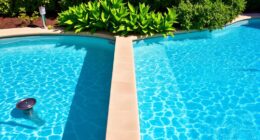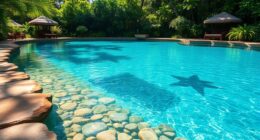Your swim spa’s energy use depends on factors like insulation, heater type, and how often you use it. Well-insulated models with efficient heaters, like heat pumps, can save you money over time, especially if you keep it covered and maintain it properly. Electric heaters might cost more to operate, but gas or heat pump options could reduce your energy bills. If you keep these tips in mind, you’ll find ways to manage your costs effectively. Keep exploring to learn more.
Key Takeaways
- Well-insulated swim spas retain heat efficiently, reducing heater energy consumption and lowering operating costs.
- Electric heaters are common but may consume more energy, especially in poorly insulated models.
- Proper insulation and high-efficiency heaters, like heat pumps, optimize energy use and can save money long-term.
- Additional features such as programmable timers and covers help manage heating schedules and reduce energy waste.
- Climate, usage patterns, and maintenance practices significantly influence overall energy consumption and costs.

Swim spas are a popular choice for fitness and relaxation, but understanding their energy use is essential to managing operating costs. One of the key factors influencing how much energy your swim spa consumes is its insulation efficiency. A well-insulated model retains heat better, reducing the workload on your heater and lowering energy bills. Look for swim spas with high-quality insulation around the walls, floors, and cover. The more efficient the insulation, the less heat escapes, meaning your heater won’t have to work as hard to maintain your desired temperature. Proper insulation is especially important if you plan to use your swim spa year-round or in cooler climates, as it helps keep heating costs predictable and manageable. Additionally, the contrast ratio of your heater and insulation can influence how quickly your spa heats up and maintains temperature, further affecting energy consumption.
Another noteworthy aspect to consider is the type of heater your swim spa uses. Different heater types vary in energy efficiency and operational costs. Electric heaters are common and generally simple to maintain, but they can be energy-intensive, especially if your spa is large or poorly insulated. Gas heaters, on the other hand, often heat water faster and may be more cost-effective in the long run if you already have access to natural gas or propane. They tend to be more energy-efficient for larger models, but keep in mind that they require proper venting and can involve higher installation costs. Heat pumps are another option; they use ambient air to generate heat, making them highly energy-efficient, especially in moderate climates. While they might have a higher upfront cost, heat pumps can substantially reduce ongoing energy expenses, making them an attractive choice for eco-conscious owners.
Your choice of heater type should align with your usage patterns, local energy prices, and climate. Combining a high-efficiency heater with a swim spa that boasts excellent insulation efficiency can lead to substantial savings over time. Additionally, consider integrating energy-saving features like programmable timers, covers, and insulation upgrades, which can further reduce operating costs. Regular maintenance also plays a crucial role—clean filters, checking for leaks, and ensuring your heater functions properly can prevent unnecessary energy waste.
Frequently Asked Questions
How Does Outdoor Climate Affect Swim Spa Energy Consumption?
Outdoor climate greatly impacts your swim spa’s energy consumption. In colder temperatures, you’ll notice higher energy use because your spa’s thermal insulation works harder to maintain the desired water temperature. Conversely, warmer ambient temperatures reduce the need for heating, saving energy. To optimize efficiency, make sure your swim spa has good thermal insulation, and consider covering it when not in use, especially during extreme weather, to minimize heat loss and energy costs.
Are There Energy-Efficient Swim Spa Models Available?
Absolutely, you can find energy-efficient swim spa models that won’t drain your wallet. These models boast eco-friendly technology and energy-efficient features like better insulation and smart controls. So, instead of turning your backyard into a money pit, you can enjoy your swim spa guilt-free, knowing you’re helping the planet and saving on bills. Who knew luxury could be so eco-savvy? Plunge into smarter choices today!
How Often Should I Service My Swim Spa for Optimal Energy Use?
You should service your swim spa every 3 to 6 months to guarantee peak energy use. Follow a regular maintenance schedule that includes cleaning filters, inspecting pumps, and checking for leaks. Additionally, implement energy-saving tips like maintaining proper water chemistry, reducing heater temperature, and covering your spa when not in use. Regular maintenance helps your spa operate efficiently, saving you money on energy bills and extending its lifespan.
Can Solar Panels Significantly Reduce Swim Spa Energy Costs?
Did you know solar panels can cut swim spa energy costs by up to 70%? Solar panel savings are significant when you consider renewable energy options. By installing solar panels, you harness free, natural energy, reducing your reliance on traditional power sources and lowering bills. This eco-friendly choice not only saves you money but also helps protect the environment, making it a smart investment for any swim spa owner looking to cut costs.
What Is the Typical Lifespan of a Swim Spa’s Heating System?
A swim spa’s heating system typically lasts around 5 to 10 years, depending on heater longevity and maintenance frequency. You should expect to replace or service the heater as it ages, especially if you notice decreased efficiency or rising energy costs. Regular maintenance, like cleaning filters and inspecting components, helps extend its lifespan, ensuring your heater continues to perform well and keeps your swim spa comfortable year-round.
Conclusion
Understanding energy use in swim spas helps you make informed decisions, manage costs, and enjoy your pool more. By knowing what to expect, you can optimize your equipment, adopt energy-saving habits, and maintain your swim spa efficiently. Awareness, awareness, awareness—stay informed, stay proactive, and stay comfortable. With these tips, you’ll maximize your swim spa experience, minimize your energy bills, and enjoy your aquatic oasis for years to come.









